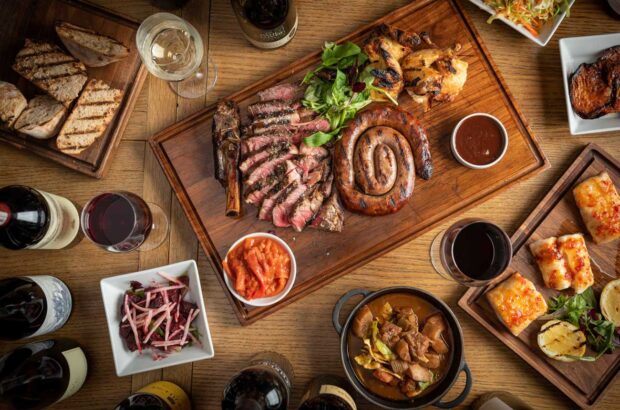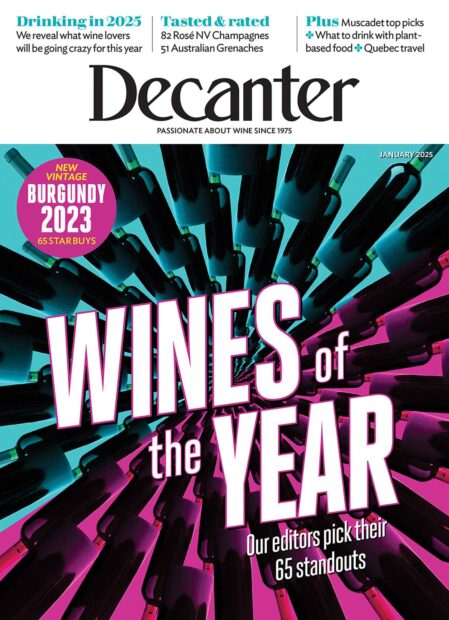Andrew Jefford tastes some 2010 Vins Jaunes – and more...
In last week’s ‘Jefford on Monday’, I described the recent ‘Vin de Voile’ Symposium organised prior to this year’s Percée de Vin Jaune in the Jura, with the participation not only of local Vin Jaune growers but of sherry producers Equipo Navazos and Williams & Humbert, too, as well as Tokaji producer Samuel Tinon. This week, let’s take a look at the wines themselves.
Tasting Vin Jaune
Six years’ ageing means that the latest vintages of Vin Jaune to reach market are 2010 and 2011. If you’re a fan of Vin Jaune, don’t let these slip by: 2010 was a small but high quality vintage, while 2011 was an abundant vintage of good to very good wines. Subsequent vintages have usually been much tougher propositions for growers, both in terms of quantity and quality, and prices will surely rise for this sought-after but necessarily rare wine style.
Buying young Vin Jaune, by the way, is a much less riskier procedure than it once was: the controls, checks, supervision and understanding of these wines has greatly improved over the last two decades, and they are much more consistent as a consequence. Connoisseurs love to age these wines further and the producers themselves often give ‘drink by’ dates three decades hence, but I’m not convinced by this: the older vintages shown at the Symposium weren’t uniformly successful, and my own preference, save in the case of truly outstanding young wines, would be to drink within five years of purchase.
Producers are listed by alphabetical order, regardless of appellation, and the wines were tasted sighted. Most wines carry a local retail price of 25€ to 35€ on release, though those of Stéphane Tissot are more expensive.
Ch d’Arlay, Côtes du Jura Vin Jaune 2010
This beautifully labelled wine, from a property formerly owned by Moët visionary and French Resistance hero Robert-Jean de Vogüé, is mid-gold in colour, with a sweeter, creamier scent than its peers and a touch of honeysuckle charm, too. Don’t be misled, though: on the palate it’s a loosed arrow: pure, long and incisive, with more elemental Savagnin character than many of its peers, modulating towards the end of the palate towards umami and nuts. Comte Alain de Laguiche, the present owner, talks of its ‘droiteur et pureté’: an accurate description. 91 (14%)
Domaine Badoz, Côtes du Jura Vin Jaune 2010
Full gold, with a scent of crushed citrus zest and white pepper in addition to some bready warmth. It’s slender and zesty on the palate, too, but with great purity, drive and vividness from the wine’s resonant acid architecture. 90 (14.5%)
Dom Baud Génération 9, Côtes du Jura Vin Jaune 2010
Full gold in colour, with a creamy, lemony scent in which bready aldehyde notes are more than usually apparent. There’s a typical Côtes du Jura acidic nerviness to this Vin Jaune, and an almost saline edge; you might also recall bread and seaweed. The palate finishes with unexpected warmth and richness, and some apricot fruit notes. Concentrated and complex. 92 (14.5%)
Fruitière Vinicole d’Arbois, Château Béthanie, Arbois Vin Jaune 2010
With 270 ha under vines, this is the Jura’s largest producer, and its 2010 Vin Jaune is a fine effort: mid-gold in colour, with fresh, bready fruit notes lent richness by the creaminess of soft, white, new-season hazels. It’s a true Arbois on the palate: broad, vivid, rich and mouthfilling, with less overt acid strike than Côtes du Jura Vins Jaunes. Its resonant orchard fruit is qualified by dried mushroom and savoury umami notes, too. Despite its amplitude, it leaves the mouth fresh and longing for more. 93 (15%)
Fruitière Vinicole de Voiteur, Château-Chalon Vin Jaune 2010
Jura has one of the oldest co-operative traditions in France, and regional standards are admirably high; the Voiteur co-operative, sited at the foot of Château-Chalon, is the largest single producer of this rare wine, vinifying a quarter of the appellation’s 55 ha of vineyard. The wine is relatively pale at present, with soft, subtle scents combining creamy sweetness and plant sap. On the palate it is refined, pure and elegant, with well-rounded lemon fruit, stony purity and a tickle of nutty, grainy complexity on the finish which a little more bottle age will certainly amplify. A classic to buy with confidence. 93 (14.5%)
Dom Henri Maire, Château-Chalon Vin Jaune 2010
Henri Maire passed into the ownership of the Boisset group in February 2015, but most of the credit for this wine should go to the Verdoso Industries team, who took over the company in 2010. It is a fine benchmark for the region, which wasn’t always true in the past: full gold in colour, with ample bready, yeasty, mushroomy aromatic intrigue. The palate in this case delivers what the nose promised with generosity and exuberance: it’s a big, bready mouthful with a clean, long, tangy and saliva-inducing finish. 91 (14.5%)
Rolet, Arbois Vin Jaune 2010
A bright mid-gold in colour, with apple, lemon, quince and forest mushroom scents. There’s a creamy undertow, and the wine is very clean and spotless. On the palate, it is intense and vivid with more acid drive and thrust to it than many Arbois peers. That insistently taut, tight, apple-lemon fruit suggests this would be better after a two or three-year wait, with plenty of ageing potential in store. 93 (14.5%)
André et Mireille Tissot, Château Chalon Vin Jaune 2010
How do you describe Stéphane Tissot? Perhaps ‘human firework’ comes closest; he fizzes and crackles with energy, bonhomie, positivity and creativity, and he and his wife Bénédicte have, in the 25 years since he took over from his father, turned this into one of the finest French domains in any region, as well as one of Jura’s most sizeable, offering a colossal range of 28 different cuvées, including three different Arbois Vin Jaune cuvées and a Château-Chalon, too. For Tissot, the difference between the two appellations is that that Château-Chalon has “more finesse, more delicate fruit and more citrus character.” That’s certainly true of this magnificent example, still a relatively pale gold in early 2018. There’s huge aromatic complexity here, if you just give it a little time to emerge: moss, woodruff, mint and lemon verbena, cushioning understated but supportive summer or light citrus fruits – though not, as yet, much nut or mushroom complexity. On the palate, the wine almost has the acidic energy and lunge of a Riesling though the allusions seeping from that acidic force are quite different – crushed stone, green plum skins and green apple with a chicory, acorn or dandelion-sap bitterness. It’s resonant, energetic and almost caustic in the mouth, yet there is a little umami warmth, too, and given time (which this wine needs) you will see a glowing shapeliness emerge. Magnificent Vin Jaune. 97 (15%)
Jacques Tissot, Arbois Vin Jaune 2010
Mid-gold in colour, with a warm, comforting, nourishing, well-rounded nose, cleanly and sweetly expressed though without great aromatic intricacy. Ripe, rounded and tangy on the palate, with warm, earthy, savoury, meat-stock flavours lending depth and intricacy to the subdued orchard fruit. 92 (14.5%)
Jean-Louis Tissot, Arbois Vin Jaune 2010
The Arbois style tends to be forceful and exuberant compared to the nuance, subtlety, grain and finesse of Château-Chalon. This mid- to full gold example from Valérie and Jean-Christophe Tissot has a mellow, rich, enveloping aromatic profile of woodland savoury sweetness and a vivid, deep palate, combining forest mushroom and simmering stock notes with ringing, singing acidity. There’s almost a tannic dimension to its structure: grand Arbois which surely has got the legs for a decade or more. 94 (14.5%)
Philippe Vandelle, L’Etoile Vin Jaune 2010
Pale gold in colour, with scents of threshed grain, dry straw and a little peach juice. Lemon, bread and dried mushrooms provide the palate allusions in this poised, resolute and firmly structured Vin Jaune. There’s a bright, ample, satisfying finish. 92 (14.5%)
Tasting the Cousins
As I suggested last week, the sensual experience of Fino and Manzanilla (produced from low-acid Palomino in multi-vintage solera systems) is a very different one to that of Vin Jaune and other voile-aged wines produced from the high-acid Savagnin produced from a single vintage.
Two wines from Spain took us a little closer to a valid comparison. The first is the unfortified Bota de Florpower from Equipo Navazos, a 12% wine from two old-vine vineyards in Sanlúcar where you can see Palomino fruit quality (and some soft acidity) as well as the effects of flor (the current release is Bota 77 MMXV from 2015). Williams & Humbert, meanwhile, offers genuine single-vintage (añada) wine as ‘Crianza Tipo Biologica’ – see a review of the 2010 below, alongside a review of Equipo Navazos’s La Bota de Fino 68 and Samuel Tinon’s 2007 Tokaji Szamorodni Száraz.
Equipa Navazos, La Bota de Fino 68, Macharnudo Alto
This solera-aged blend draws all its new wines from the celebrated albariza vineyards of Macharnudo Alto. The flor in the solera stage itself, from which the wine is bottled, is almost exhausted – though this is drawn from the first and second criaderas, which are richer in flor, as well as the solera itself. It’s a pale burnished gold in colour with scents of milled grain, seaweed, anis and green tea, with creamy, almost chewy flor flavours of impressive breadth and depth. 93 (15%)
Williams Colección Añadas, Fino En Rama, Crianza Tipo Biológica 2010
This lightly fortified wine, from the albariza vineyards of Añina and Carrascal, is translucent pewter-gold with gently bready scents but a subdued fruit warmth, too. That fruit aroma disappears on the palate, though, which is low acid (4 g/l), plump and rounded, but bright and alive with chewy, tingly-tangy flor character; you do feel you are getting much closer to the flor in this wine than in most vins jaunes. 92 (15%)
Samuel Tinon, Tokaji Szamarodni Száraz 2007
An unfortified wine made from 90% Furmint with 10% Hárslevelű harvested at one moment using healthy, shrivelled and botrytised grapes which are fermented together to dryness. The wine is a light, translucent tawny in colour, with scents of dry leaves, varnish and old library bookshelves – the oxidative elements, in other words, are more prominent than any legacy of the voile. On the palate, the wine is tangy, bright, light, open and very clean, with something of the searching acidity of Vin Jaune (5.1 g/l here) and a dusty-apricot fruit complexity. 89 (13.8%).







